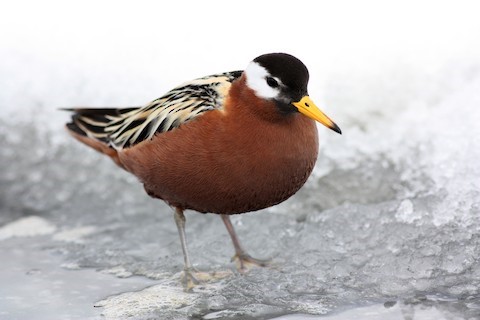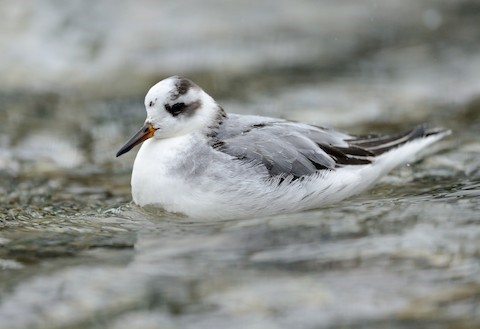Birdfinding.info ⇒ Common on its arctic breeding grounds, where it can be seen in a few accessible sites, such as Barrow, Alaska, from June through August. Otherwise primarily pelagic and infrequently seen near land. During migration and winter, it is often seen on offshore trips from the West and East Coasts of the U.S., especially in California waters, where it occurs almost year-round. From September into November, a few scattered migrants appear on lakes and reservoirs throughout North America—especially on the Great Lakes.
Red Phalarope
Phalaropus fulicarius
Breeds on high arctic tundra. Winters at sea.
Breeding. Breeds in June and July in low-lying marshy tundra all around the arctic, including Alaska, Canada, Greenland, Iceland, Scandinavia, and the full length of Russia.
Main nesting areas include: the western and northern coastal plains of Alaska; Canada’s Arctic Archipelago south to northernmost Quebec and Labrador; coastal western Greenland; Iceland; Svalbard; Novaya Zemlya; and locally along the northern coastal plain of Siberia, including Wrangel Island, east to Chukotka.
Nonbreeding. Winters at sea mainly in two areas: in the Humboldt Current offshore from Peru and Chile, and in the Benguela Current offshore from Namibia and South Africa.
Additional wintering areas that may host substantial populations include: (1) the eastern Pacific from California to Central America; (2) the western North Atlantic along the Gulf Stream; (3) the eastern Atlantic from the Canary Islands to Cape Verde; (4) the central Pacific, including Hawaiian waters; and (5) the western Pacific, including the East China and South China Seas.
Much smaller numbers apparently winter annually in the Arabian Sea.
Movements. Migration is overwhelmingly via oceanic routes, with no known significant overland movements. However, a significant portion is in near-coastal waters, and flocks or lone individuals sometimes appear at the shore, especially during storms.

Red Phalarope, female in breeding plumage at a coastal location on migration. (Churchill, Manitoba; June 7, 2009.) © Jay McGowan
Most northbound migration through temperate latitudes occurs during a compressed period, mainly late April and May.
Southbound migration is protracted, beginning in late June with the departure of females almost immediately after laying their eggs. Males and juveniles depart the breeding grounds over the course of mid-July to mid-September, with some juveniles remaining in arctic waters into October.
Some portion of the population remains at fairly high latitudes of the North Pacific and North Atlantic into December.
Vagrants can occur nearly anywhere in the world and have been recorded from, e.g.: Amazonian Brazil, Argentina, Sri Lanka, Thailand, Australia, New Zealand, and the Antarctic Peninsula.
Identification
A peculiar shorebird which turns red for its brief arctic breeding season, and spends the rest of the year gray-and-white on the high seas.
Like other phalaropes, Red reverses the usual sex roles: females are larger and more colorful than males, and depart immediately after laying the eggs.
Unlike other phalaropes, its bill is fairly thick, and in breeding adults it is mostly yellow with a dark tip. In nonbreeders, the bill turns mostly blackish, often with a paler base.

Red Phalarope, female in breeding plumage. (Barrow, Alaska; June 23, 2019.) © August Davidson-Onsgard
Female in breeding plumage has deep brick-red body and strongly pattern upperparts: mostly blackish feathers with buffy edges. The breeding female has a mostly black head with a broad white mask.
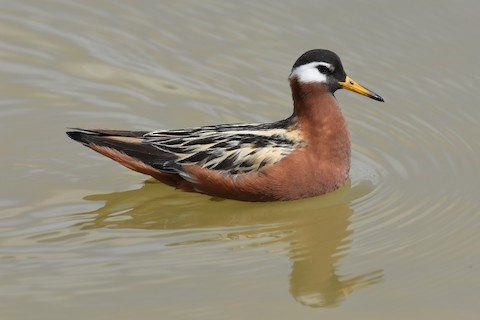
Red Phalarope, female in breeding plumage. (Jersey Village, Texas; June 1, 2019.) © Janet Rathjen

Red Phalarope, female in breeding plumage. (Bourbonhamna, Svalbard; June 19, 2019.) © Noah Strycker
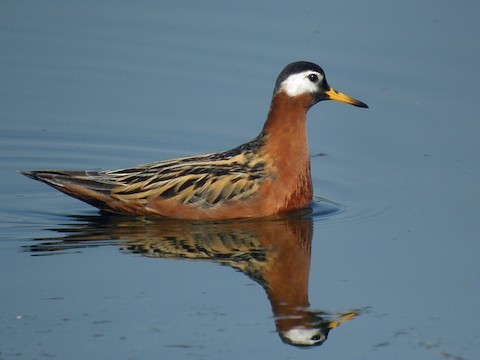
Red Phalarope, female in breeding plumage. (Seiches-sur-la-Loire, France; May 24, 2012.) © Alain Fossé

Red Phalarope, female in breeding plumage. (Yuma, Arizona; May 21, 2020.) © Mary McSparen

Red Phalarope, female in breeding plumage. (Barrow, Alaska; June 10, 2018.) © Bradley Hacker

Red Phalarope, female in breeding plumage. (Arroyo Laguna, San Simeon, California; July 10, 2018.) © Tom Edell
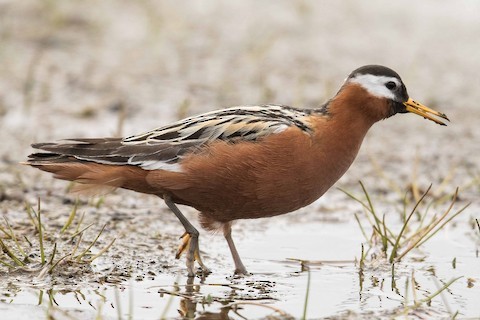
Red Phalarope, female in breeding plumage. (St. Paul Island, Alaska; June 5, 2015.) © Eric VanderWerf

Red Phalarope, female in breeding plumage. (Antone Lake, St. Paul Island, Alaska; June 5, 2019.) © Paul Budde

Red Phalarope, molting into breeding plumage. (Point Pinos, California; May 6, 2017.) © Paul Fenwick
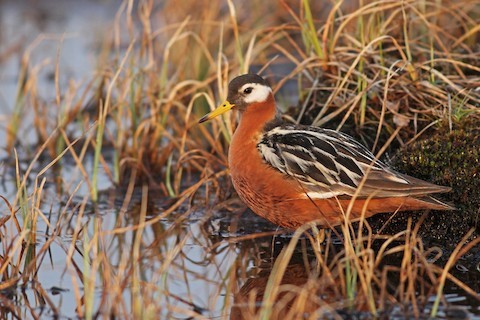
Red Phalarope, female in breeding plumage. (Canning River Delta, Arctic National Wildlife Refuge, Alaska; June 22, 2013.) © Ian Davies
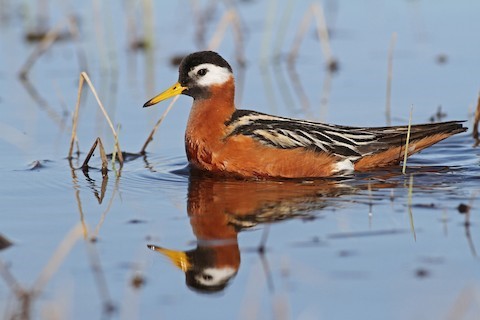
Red Phalarope, female in breeding plumage. (Canning River Delta, Arctic National Wildlife Refuge, Alaska; June 20, 2013.) © Ian Davies
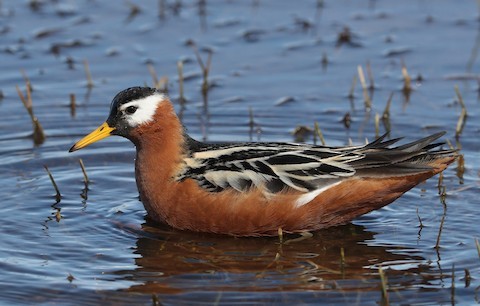
Red Phalarope, female in breeding plumage. (Barrow, Alaska; June 9, 2017.) © Hal and Kirsten Snyder

Red Phalarope, female in breeding plumage. (Churchill, Manitoba; June 7, 2009.) © Jay McGowan

Red Phalarope, female in breeding plumage. (Churchill, Manitoba; June 7, 2009.) © Jay McGowan

Red Phalarope, female in breeding plumage. (Fresh Water Lake Road, Barrow, Alaska; June 30, 2018.) © Ian Davies
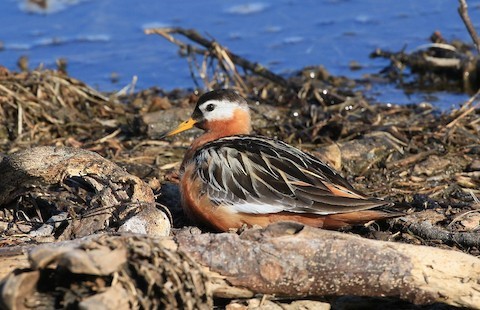
Red Phalarope, female in breeding plumage. (Arroyo Laguna, San Simeon, California; July 10, 2018.) © Roger Zachary

Red Phalarope, female in breeding plumage. (Churchill, Manitoba; June 7, 2009.) © Jay McGowan

Red Phalarope, female in breeding plumage. (Barrow, Alaska; June 19, 2016.) © Lars Petersson

Red Phalarope, female in breeding plumage. (Fresh Water Lake Road, Barrow, Alaska; June 29, 2018.) © Ian Davies

Red Phalarope, female in breeding plumage. (Cake Eater Road, Barrow, Alaska; June 15, 2017.) © Eric Gofreed
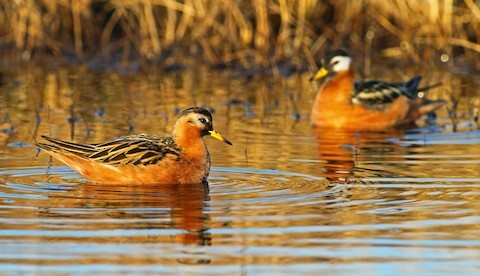
Red Phalarope, male and female in breeding plumage. (Barrow, Alaska; June 13, 2013.) © Andrew Spencer
Male in breeding plumage looks like a washed-out version of the female, with the objective distinction that its crown is streaked.

Red Phalarope, male in breeding plumage. (Fresh Water Lake Road, Barrow, Alaska; June 29, 2018.) © Ian Davies
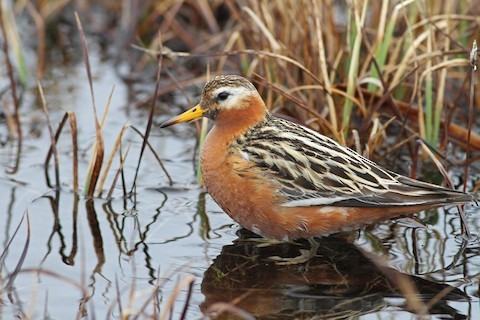
Red Phalarope, male in breeding plumage. (Canning River Delta, Arctic National Wildlife Refuge, Alaska; June 16, 2013.) © Ian Davies

Red Phalarope, male in breeding plumage. (Barrow, Alaska; June 13, 2013.) © Andrew Spencer

Red Phalarope, male in breeding plumage. (St. Paul Island, Alaska; June 5, 2015.) © Eric VanderWerf

Red Phalarope, male in breeding plumage. (Herschel Island, Yukon Territory; June 13, 2019.) © Cameron Eckert
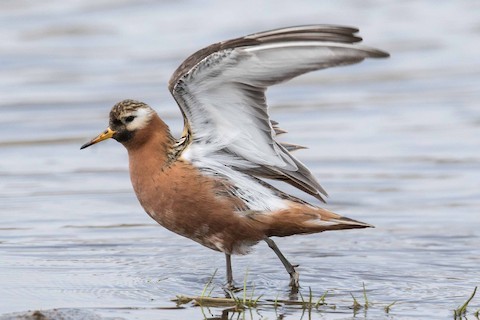
Red Phalarope, male in breeding plumage. (St. Paul Island, Alaska; June 5, 2015.) © Eric VanderWerf
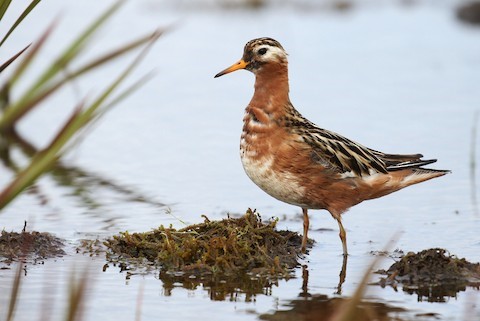
Red Phalarope, male in breeding plumage. (Canning River Delta, Arctic National Wildlife Refuge, Alaska; July 3, 2017.) © Alex Lamoreaux

Red Phalarope, male in breeding plumage. (Salinas River National Wildlife Refuge, California; May 30, 2007.) © Blake Matheson
Adults in nonbreeding plumage are mostly pale-gray above and have a distinctive (but shared by nonbreeding Red-necked Phalarope) blackish mask-stripe that extends from around the eye back to the ear-coverts. At a distance, their most distinctive feature is prominent white wing-stripe.
The rump pattern is peculiarly variable, which causes some confusion with Red-necked. Many individuals show a divided rump (dark in the middle, white on the sides), but many others show a uniformly gray rump or a whitish rump band.

Red Phalarope, nonbreeding plumage. (Tarifa, Cádiz, Andalucía, Spain; January 1, 2010.) © Yeray Seminario

Red Phalarope, nonbreeding plumage. (Pelican Island, Dauphin Island, Alabama; October 15, 2016.) © Wayne Patterson
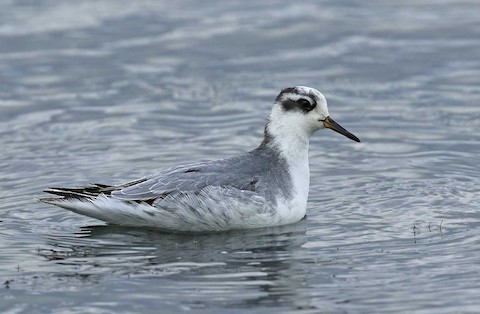
Red Phalarope, nonbreeding plumage. (Pennington Marshes, Hampshire, England; October 28, 2017.) © Dave Bakewell
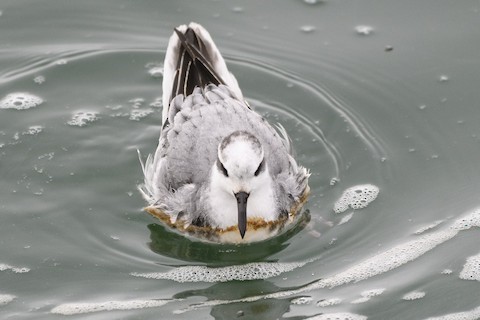
Red Phalarope, nonbreeding plumage. (Eames Substation, Idaho Falls, Idaho; October 28, 2019.) © Darren Clark

Red Phalarope, nonbreeding plumage. (Humboldt Bay, California; November 21, 2016.) © Jeff Todoroff

Red Phalarope, nonbreeding plumage. (Calgary, Alberta; September 18, 2020.) © Ethan Denton

Red Phalarope, nonbreeding plumage. (Tarifa, Cádiz, Andalucía, Spain; January 1, 2010.) © Yeray Seminario
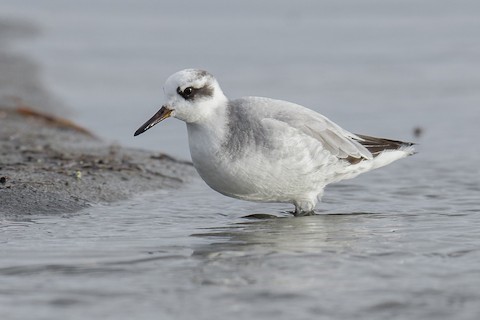
Red Phalarope, nonbreeding plumage. (Popcorn Rock, Pyramid Lake, Nevada; November 28, 2016.) © Jeff Bleam
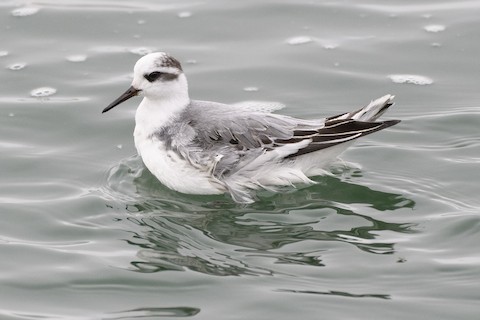
Red Phalarope, nonbreeding plumage. (Eames Substation, Idaho Falls, Idaho; October 28, 2019.) © Darren Clark
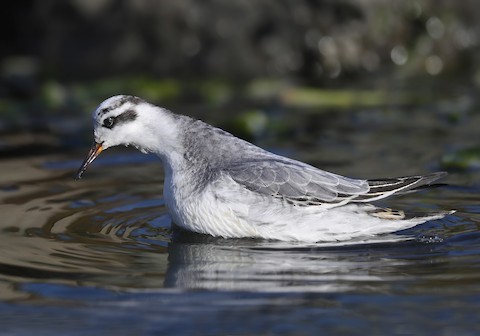
Red Phalarope, nonbreeding plumage. (Bodega Bay, California; November 25, 2018.) © Matt Davis
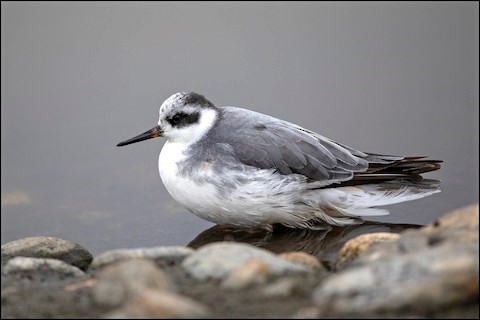
Red Phalarope, nonbreeding plumage. (Mungi Lake, Arcadia, California; September 1, 2018.) © Judi Hwa

Red Phalarope, nonbreeding plumage. (Humboldt Bay, California; November 18, 2016.) © Justyn Stahl
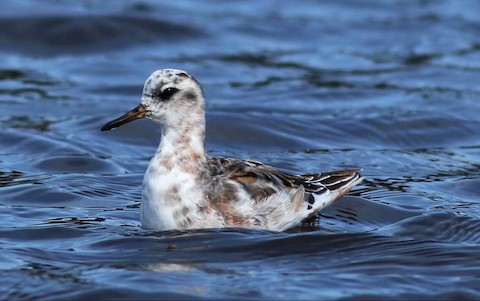
Red Phalarope, molting into breeding plumage. (Point Pinos, California; May 6, 2017.) © Paul Fenwick
Immatures generally resemble nonbreeding adults, but go through a briefly-held juvenile plumage in which the upperparts appear mostly streaked, with dark feather centers and buffy edges. By the time they have migrated south to temperate latitudes, most juveniles have already replaced most of these feathers and appear largely pale-gray like nonbreeding adults.
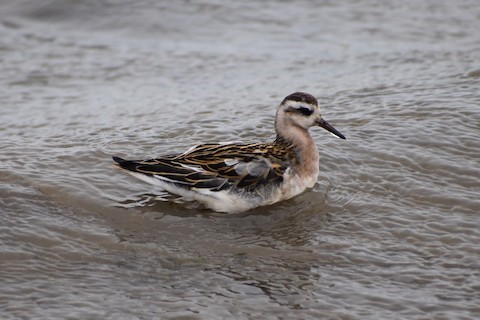
Red Phalarope, juvenile. (Braddock Bay, New York; September 9, 2018.) © Robert Buckert

Red Phalarope, molting from juvenile into nonbreeding plumage. (Holland State Park, Ottawa County, Michigan; September 3, 2019.) © Brendan Klick

Red Phalarope, molting from juvenile into nonbreeding plumage. (Whitehorse, Yukon; October 12, 2012.) © Cameron Eckert
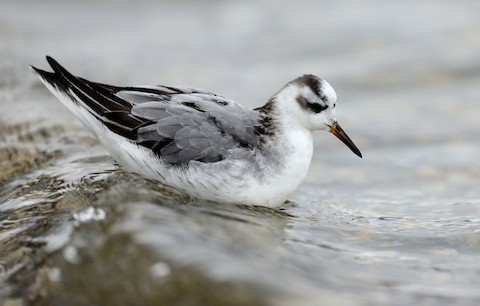
Red Phalarope, molting from juvenile into nonbreeding plumage. (Hlučínská Šštěrkovna, Moravskoslezský Kraj, Czechia; January 5, 2019.) © Pavel Štěpánek

Red Phalarope, molting from juvenile into nonbreeding plumage. (Stuyvesant Cove Park, Manhattan, New York; September 12, 2020.) © Gloria
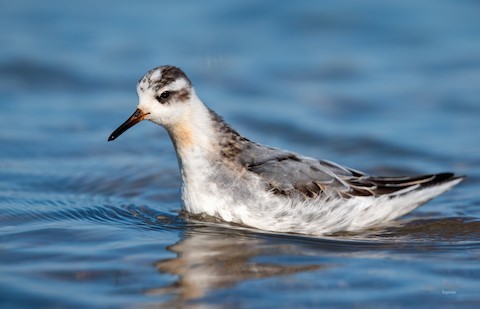
Red Phalarope, molting from juvenile into nonbreeding plumage age. (Rocky River Park, Rocky River, Ohio; October 31, 2020.) © Shailesh Pinto

Red Phalarope, molting from juvenile into nonbreeding plumage. (Seeburger See, Niedersachsen, Germany; October 31, 2020.) © Volker Hesse
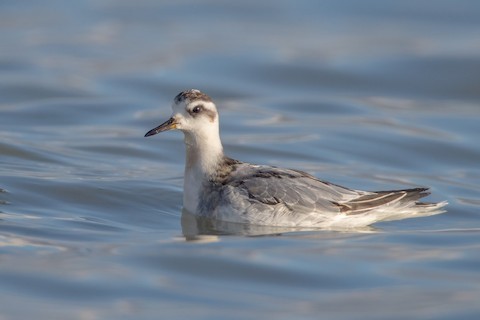
Red Phalarope, molting from juvenile into nonbreeding plumage. (Muskegon Wastewater System, Muskegon, Michigan; October 24, 2018.) © Brendan Klick
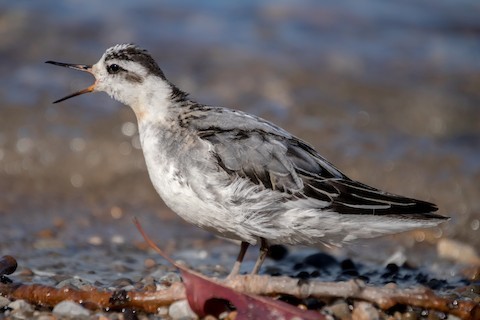
Red Phalarope, molting from juvenile into nonbreeding plumage. (Rocky River Park, Rocky River, Ohio; October 31, 2020.) © Anthony Rodgers

Red Phalarope, molting from juvenile into nonbreeding plumage. (Forest Sewage Lagoons, Lambton Shores, Ontario; October 18, 2019.) © Matt Parsons

Red Phalarope, female in breeding plumage. (Yuma, Arizona; May 21, 2020.) © Mary McSparen

Red Phalarope, female in breeding plumage. (Yuma, Arizona; May 21, 2020.) © Mary McSparen
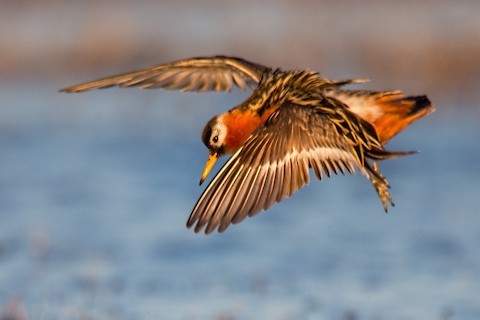
Red Phalarope, female in breeding plumage. (Cake Eater Road, Barrow, Alaska; June 15, 2017.) © Eric Gofreed

Red Phalarope, female in breeding plumage. (Yuma, Arizona; May 21, 2020.) © Caleb Strand
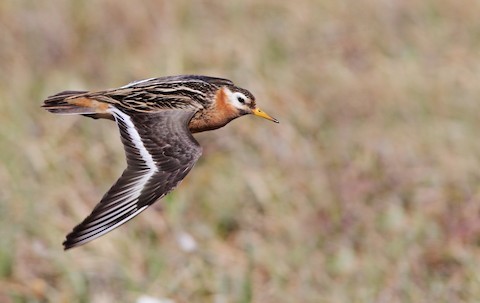
Red Phalarope, male in breeding plumage. (Canning River Delta, Arctic National Wildlife Refuge, Alaska; July 14, 2013.) © Ian Davies

Red Phalarope, male molting into nonbreeding plumage. (Offshore from Half Moon Bay, California; August 18, 2018.) © Adam Dudley
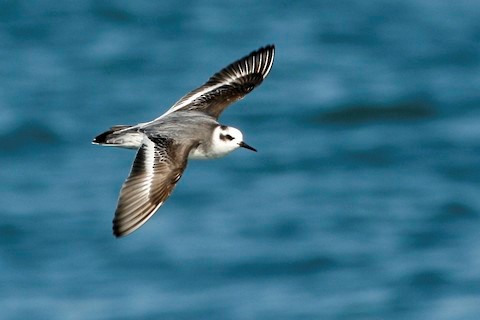
Red Phalarope, nonbreeding plumage. (Santa Barbara Channel, California; December 24, 2014.) © Oscar Johnson

Red Phalarope, nonbreeding plumage. (Bodega Bay, California; December 4, 2016.) © Alan Wight
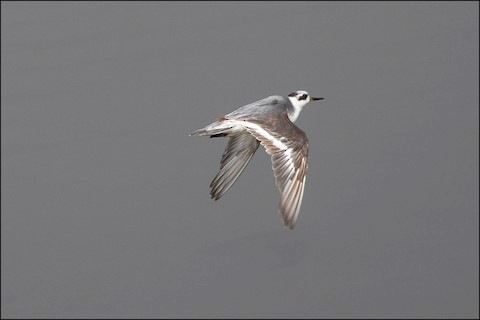
Red Phalarope, nonbreeding plumage. (Mungi Lake, Arcadia, California; September 1, 2018.) © Judi Hwa

Red Phalarope, nonbreeding plumage. (Wiarton, Ontario; November 12, 2017.) © Kiah Jasper

Red Phalarope, nonbreeding plumage. (Miller Knox Regional Shoreline, Richmond, California; September 27, 2020.) © Robert Lewis
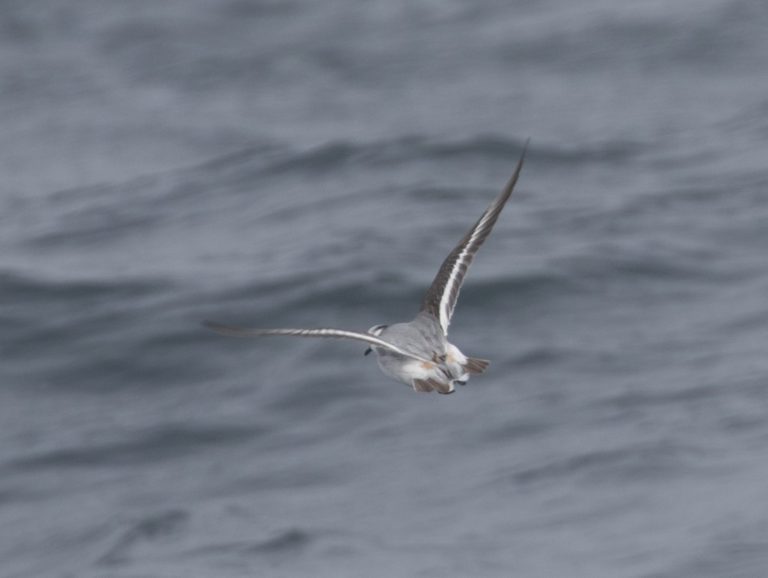
Red Phalarope, nonbreeding plumage. (Offshore from Santa Cruz, California; August 22, 2020.) © avocat

Red Phalarope, nonbreeding plumage. (Offshore from Monterey, California; August 27, 2017.) © Brian Sullivan
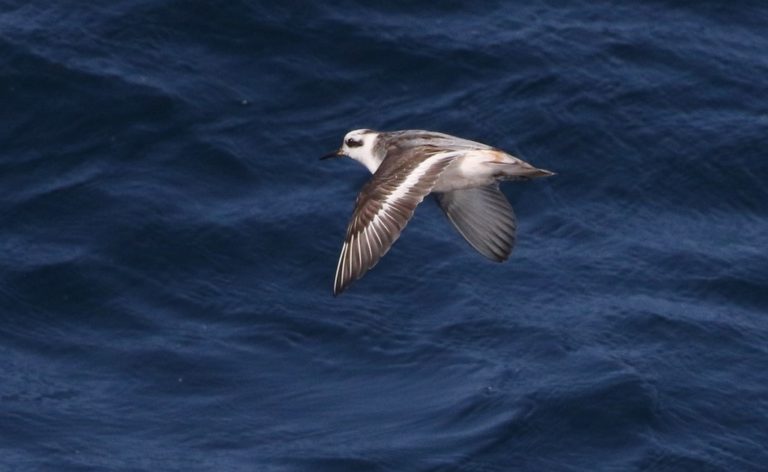
Red Phalarope, nonbreeding plumage. (Offshore from San Clemente Island, California; August 25, 2018.) © James Bailey

Red Phalarope, juvenile. (Braddock Bay Wildlife Management Area, New York; September 11, 2018.) © Joe Wing
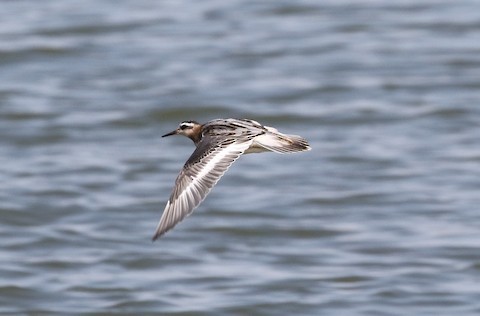
Red Phalarope, juvenile. (Chatfield State Park, Highlands Ranch, Colorado; September 11, 2017.) © Mark Chavez
Cf. Red-necked Phalarope. Red-necked and Red Phalaropes are the only two pelagic sandpipers, and often flock together at sea. Their normal ranges overlap widely and because both are world travelers they can occur anywhere. The nonbreeding plumages are readily confused, especially under suboptimal maritime viewing conditions.
Both species are also somewhat variable in their nonbreeding plumages, so it is difficult to make reliable generalizations, but in most cases the general coloration of the upperparts is strong indicator: Red tends to have extensively pale-gray upperparts, where Red-necked tends to be medium-gray—and usually also has darker streaks. However, some Red-necks have unmarked uniform-gray upperparts, and some first-year Reds retain darker, partly streaked remnants of the juvenile plumage.
Red-necked tends to show more contrast on the rump: blackish in the center and white or whitish on the sides. Red’s rump varies and can also show a dark center and white or whitish sides, but the contrast is less pronounced, so it appears more evenly grayish (and sometimes very pale, whitish overall—totally unlike Red-necked). The tails also differ somewhat, as Red tends to appear broad and Red-necked narrow.
If seen clearly at close range, the bill shapes can also be diagnostic. Red-necked has a thinner, medium-length bill that is always black, whereas Red has a comparatively short, broad bill that is yellow in the breeding season and at other times can appear all-black but often shows some paler coloration, especially around the base.
Their voices also differ. Red-necked’s typical calls are sharp, medium-pitched chip notes whereas Red’s are either high-pitched, metallic chip notes or more textured, throaty seep notes.

Red (at left) and Red-necked Phalaropes in nonbreeding plumage, showing subtle differences in back, rump, and tail patterns. (Nantucket, Massachusetts; September 22, 2019.) © Benjamin Hack
Notes
Monotypic species.
References
Alderfer, J., and J.L. Dunn. 2014. National Geographic Complete Birds of North America (Second Edition). National Geographic Society, Washington, D.C.
BirdLife International. 2018. Phalaropus fulicarius. The IUCN Red List of Threatened Species 2018: e.T22693494A132531581. https://dx.doi.org/10.2305/IUCN.UK.2018-2.RLTS.T22693494A132531581.en. (Accessed November 11, 2020.)
Brazil, M. 2009. Birds of East Asia. Princeton University Press.
de la Peña, M.R., and M. Rumboll. 1998. Birds of Southern South America and Antarctica. Princeton University Press.
eBird. 2020. eBird: An online database of bird distribution and abundance. Cornell Lab of Ornithology, Ithaca, N.Y. http://www.ebird.org. (Accessed November 11, 2020.)
Garcia-del-Rey, E. 2011. Field Guide to the Birds of Macaronesia: Azores, Madeira, Canary Islands, Cape Verde. Lynx Editions, Barcelona.
Hollom, P.A.D., R.F. Porter, S. Christensen, and I. Willis. 1988. Birds of the Middle East and North Africa. T & AD Poyser, Calton, England.
Howell, S.N.G., and S. Webb. 1995. A Guide to the Birds of Mexico and Northern Central America. Oxford University Press.
Howell, S.N.G., and K. Zufelt. 2019. Oceanic Birds of the World. Princeton University Press.
Jaramillo, A. 2003. Birds of Chile. Princeton University Press.
Johnson, S.R., and D.R. Herter. 1989. The Birds of the Beaufort Sea. BP Exploration (Alaska) Inc., Anchorage, Alaska.
Kirwan, G.M., A. Levesque, M. Oberle, and C.J. Sharpe. 2019. Birds of the West Indies. Lynx Edicions, Barcelona.
Marchant, J., T. Prater, and P. Hayman. 1986. Shorebirds: An Identification Guide to the Waders of the World. Houghton Mifflin, Boston.
McMullan, M., and T. Donegan. 2014, Field Guide to the Birds of Colombia (Second Edition). Fundación Proaves de Colombia, Bogotá.
Mullarney, K., L. Svensson, D. Zetterström, and P.J. Grant. 1999. Birds of Europe. Princeton University Press.
Pyle, R.L., and P. Pyle. 2017. The Birds of the Hawaiian Islands: Occurrence, History, Distribution, and Status. Version 2 (January 1, 2017). http://hbs.bishopmuseum.org/birds/rlp-monograph/. B.P. Bishop Museum, Honolulu, Hawaii.
Raffaele, H., J. Wiley, O. Garrido, A. Keith, and J. Raffaele. 1998. A Guide to the Birds of the West Indies. Princeton University Press.
Ridgely, R.S., and P.J. Greenfield. 2001. The Birds of Ecuador, Volume II: Field Guide. Cornell University Press.
Ridgely, R.S., and J.A. Gwynne. 1989. A Guide to the Birds of Panama (Second Edition). Princeton University Press.
Schulenberg, T.S., D.F. Stotz, D.F. Lane, J.P. O’Neill, and T.A. Parker. 2007. Birds of Peru. Princeton University Press.
Sibley, D.A. 2000. The Sibley Guide to Birds. Alfred A. Knopf. New York.
Sinclair, I., P. Hockey, W. Tarboton, and P. Ryan. 2011. Birds of Southern Africa (Fourth Edition). Random House Struik (Pty) Ltd. Cape Town, South Africa.
Wells, J.V., and A.C. Wells. 2017. Birds of Aruba, Bonaire, and Curaçao. Cornell University Press.
Xeno-Canto. 2020. Red Phalarope – Phalaropus fulicarius. https://www.xeno-canto.org/species/Phalaropus-fulicarius. (Accessed November 11, 2020.)
